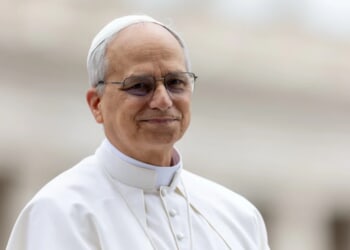Ukraine is resisting concessions, Russia is escalating nuclear threats and denouncing NATO involvement, and Western peacekeeping proposals stir controversy.
Ukraine has refused to agree with the U.S.-led peace plan that would essentially give territory, including Crimea, to Russia in exchange for almost nothing.
Moreover, Moscow has called for Ukraine to guarantee permanent neutrality and never join the NATO alliance, which has labeled those demands as nonstarters.
In response, it would seem Russia has returned to a familiar playbook, namely, it suggested it could employ nuclear weapons if it is threatened.
Last November, Russian President Vladimir Putin signed an update to Russia’s nuclear doctrine that reaffirmed atomic weapons remain a last resort to safeguard Russia’s sovereignty, but expanded the scope of threats warranting atomic deterrence. That included attacks by non-nuclear states that are backed by nuclear powers.
In other words: Ukraine.
If Kyiv were to launch a conventional strike on Russia’s cities that included the use of Western-supplied weapons, then Moscow could see such an attack as coming from the West directly. The move last November was made after the Biden Administration approved Kyiv’s use of long-range U.S.-made missiles against Russia.
On Thursday, Russian Presidential spokesperson Dmitry Peskov stated that the revised nuclear doctrine is clear regarding the conditions in which Russia might employ nuclear weapons.
“Our doctrine clearly outlines the conditions under which nuclear weapons may be used. According to the Russian state news agency Tass, this doctrine is available to the public,” Peskov said in a press conference.
Russia Doubles Down Against Peace Talks, Ready to Press “the Red Button”
Peskov’s statement followed comments made by Russian Security Council Secretary Sergey Shoigu, who had told Tass earlier in the day that any deployment of Western military personnel into Ukraine, even in a peacekeeping capacity, could be seen as an escalation leading to World War III.
Moscow has vehemently opposed any deal that could see Western peacekeeping troops deployed to Ukraine as part of a ceasefire to end the fighting.
“Sensible politicians in Europe understand that the implementation of this scenario may lead to a confrontation between NATO and Russia or even cause WWIII further down the road,” Shoigu warned.
He further suggested that such personnel would conceal the West’s attempt to gain control of Ukraine and its mineral resources.
“It could be more correct to call such troops invaders or occupants,” Shoigu added. “For these would be troops from those NATO countries whose presence Russia opposed even before the special military operation.”
The former Russian defense minister and close ally of Putin, also claimed without merit or evidence that the “peacekeepers” would be used by what he said is the “Nazi regime” in Kyiv to persecute the followers of the Russian Orthodox Church and “deprive the Russian-speaking population” in Ukraine from speaking their native language while also stripping away their culture and traditions.
“This would not be a peacekeeping mission,” the Russian Security Council secretary concluded, stressing that “the real global majority has shown little inclination to join similar ’peacekeeping’ initiatives.”
Trump Expresses Frustration with Ukraine Peace Talks
President Donald Trump, who has expressed frustration with Ukrainian President Volodymyr Zelensky for refusing to agree to the peace terms suggested by Washington, has threatened to walk away entirely from the peace process. Trump famously campaigned to end the war “on day one.”
Still, peace talks have stalled as he approaches the 100th day of his administration, which political pundits use to gauge an administration’s early success.
There is growing speculation that the White House may simply wash its hands of the conflict, arguing that Ukraine is unwilling to accept losses for peace. Trump has also called upon Europe to take a greater role in the peace process and provide security to Kyiv.
According to Newsweek, one of the current proposals calls for “European troops to monitor a ceasefire along the 620-mile front line, although there is no confirmation that this is close to happening.”
The magazine of record also cited figures from Zelensky in January that stated that more than 200,000 troops would be required.
That suggestion is what Shoigu labeled an occupation force, not peacekeeping, even as Zelensky floated the idea.
No Ukraine Peace Deal, No Mineral Deal
For the White House, failing to secure a peace deal may also mean that the U.S. can secure access to Ukraine’s minerals. The Eastern European country has nearly two dozen of the fifty minerals the U.S. Department of the Interior deemed “strategically critical.”
That includes titanium, which is used in aerospace, chemical processing, and medical devices, and lithium, a key component in battery technology. In addition, Ukraine has large deposits of uranium, graphite, manganese, and rare earth metals such as ytterbium and promethium.
Yet, as Brandon J. Weichert wrote for The National Interest in early February, just weeks into Trump’s second term, “If the new American president is committed to the notion of owning Ukraine’s rare earth minerals, then the United States is going to be seeing more, not less, conflict with Russia.”
Perhaps Trump, who is known to make everything transactional, has come to see that America has no upside. The U.S. may no longer be committed to peace in Ukraine because it doesn’t want a presence there.
That may be good news for the Kremlin.
About the Author: Peter Suciu
Peter Suciu has contributed over 3,200 published pieces to more than four dozen magazines and websites over a thirty-year career in journalism. He regularly writes about military hardware, firearms history, cybersecurity, politics, and international affairs. Peter is also a Contributing Writer for Forbes and Clearance Jobs. He is based in Michigan. You can follow him on Twitter: @PeterSuciu. You can email the author: [email protected].
Image Credit: Shutterstock/ Joshua Sukoff.
















